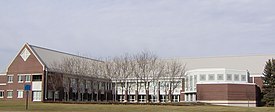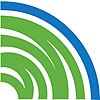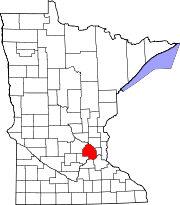Brooklyn Park, Minnesota
 From Wikipedia - Reading time: 13 min
From Wikipedia - Reading time: 13 min
Brooklyn Park, Minnesota | |
|---|---|
 Brooklyn Park City Hall in November 2006 | |
 | |
| Coordinates: 45°05′39″N 93°21′23″W / 45.09417°N 93.35639°W | |
| Country | United States |
| State | Minnesota |
| County | Hennepin |
| Settled | 1852 |
| Organized | May 11, 1858 |
| Incorporated (village) | April 14, 1954 |
| Incorporated (city) | 1969 |
| Government | |
| • Mayor | Hollies J. Winston |
| • Councilmembers | Amanda Cheng Xiong Christian Eriksen Nichole Klonowski Shelle Page Maria Tran Tony McGarvey |
| Area | |
• City | 26.549 sq mi (68.762 km2) |
| • Land | 26.076 sq mi (67.536 km2) |
| • Water | 0.473 sq mi (12.240 km2) 1.89% |
| Elevation | 866 ft (264 m) |
| Population | |
• City | 86,478 |
• Estimate (2023)[5] | 82,017 |
| • Rank | US: 437th MN: 6th |
| • Density | 3,144.0/sq mi (1,214.0/km2) |
| • Urban | 2,914,866 (US: 16th) |
| • Metro | 3,712,020 (US: 16th) |
| Time zone | UTC−6 (Central) |
| • Summer (DST) | UTC−5 (CDT) |
| ZIP Codes | 55428, 55429, 55443, 55444, 55445 |
| Area code | 763 |
| FIPS code | 27-07966 |
| GNIS feature ID | 0640511[3] |
| Sales tax | 8.525%[6] |
| Website | brooklynpark.org |
Brooklyn Park is a suburban city on the west bank of the Mississippi River, upstream from (north of) downtown Minneapolis in northern Hennepin County. It is the sixth-largest city in the U.S. state of Minnesota. The population was 86,478 at the 2020 census.[4] The city still has undeveloped land and farms, including the historic Eidem Homestead, a 1900s working farm that is a popular tourist attraction for families and school field trips.[7] Brooklyn Park is considered both a second- and third-tier suburb of Minneapolis, because much of the land north of 85th Avenue was developed after 2000.
WWE Hall of Fame wrestler Jesse Ventura served as mayor of Brooklyn Park from 1991 to 1995. He was elected governor of Minnesota in the 1998 election on a third-party ticket and served as governor from 1999 to 2003.[8]
Brooklyn Park is listed as a "Tree City USA" and is home to 47 miles (76 km) of trails and 67 parks, including Rush Creek Regional Trail and the northern section of Palmer Lake Park. The city is also known for Mississippi Gateway Regional Park, on the west side of Coon Rapids Dam Regional Park. Rasmussen University, North Hennepin Community College and a campus of Hennepin Technical College are in the city.
History
[edit]Settlers from Michigan formally organized town government in 1858 and named the area after their hometown of Brooklyn, Michigan. Formerly Brooklyn Township, the township split in 1911 when the southeast community incorporated into Brooklyn Center. Brooklyn Township was incorporated as the Village of Brooklyn Park in 1954, and incorporated as a city in 1969.[8]
Geography
[edit]According to the United States Census Bureau, the city has a total area of 26.549 square miles (68.76 km2), of which 26.076 square miles (67.54 km2) is land and 0.473 square miles (1.23 km2), or 1.89% are water.[2] The Mississippi River forms the eastern boundary of the city, separating it from Coon Rapids and Fridley in Anoka County.
Interstates 94 and 694 are located in the far southern portion of Brooklyn Park. U.S. Route 169 is located near the western part of the city. State Highway 252, a 4.5-mile (7.2 km) north–south highway, is located near the eastern portion of the city. State Highway 610 runs east–west through the northern portion of Brooklyn Park. County Road 81 also serves as one of the main routes.
Demographics
[edit]| Census | Pop. | Note | %± |
|---|---|---|---|
| 1860 | 608 | — | |
| 1870 | 1,024 | 68.4% | |
| 1880 | 1,060 | 3.5% | |
| 1890 | 1,254 | 18.3% | |
| 1900 | 1,232 | −1.8% | |
| 1910 | 1,268 | 2.9% | |
| 1920 | 948 | −25.2% | |
| 1930 | 1,107 | 16.8% | |
| 1940 | 1,334 | 20.5% | |
| 1950 | 3,065 | 129.8% | |
| 1960 | 10,197 | 232.7% | |
| 1970 | 26,230 | 157.2% | |
| 1980 | 43,332 | 65.2% | |
| 1990 | 56,381 | 30.1% | |
| 2000 | 67,388 | 19.5% | |
| 2010 | 75,781 | 12.5% | |
| 2020 | 86,478 | 14.1% | |
| 2023 (est.) | 82,017 | [5] | −5.2% |
| U.S. Decennial Census[9] 2020 Census[4] | |||
2020 census
[edit]| Race / Ethnicity (NH = Non-Hispanic) | Pop 2000[10] | Pop 2010[11] | Pop 2020[12] | % 2000 | % 2010 | % 2020 |
|---|---|---|---|---|---|---|
| White alone (NH) | 47,365 | 37,948 | 33,584 | 70.29% | 50.08% | 38.84% |
| Black or African American alone (NH) | 9,583 | 18,321 | 25,228 | 14.22% | 24.18% | 29.17% |
| Native American or Alaska Native alone (NH) | 355 | 313 | 351 | 0.53% | 0.41% | 0.41% |
| Asian alone (NH) | 6,193 | 11,658 | 16,261 | 9.19% | 15.38% | 18.80% |
| Pacific Islander alone (NH) | 42 | 26 | 14 | 0.06% | 0.03% | 0.02% |
| Other race alone (NH) | 129 | 215 | 403 | 0.19% | 0.28% | 0.47% |
| Mixed race or Multiracial (NH) | 1,777 | 2,459 | 4,048 | 2.64% | 3.24% | 4.68% |
| Hispanic or Latino (any race) | 1,944 | 4,841 | 6,589 | 2.88% | 6.39% | 7.62% |
| Total | 67,388 | 75,781 | 86,478 | 100.00% | 100.00% | 100.00% |
As of the 2020 census, there were 86,478 people, 28,749 households, 20,543 families residing in the city.[13] The population density was 3,316.4 inhabitants per square mile (1,280.5/km2). There were 29,656 housing units. The racial makeup of the city was 39.7% White, 29.5% African American, 0.6% Native American, 18.9% Asian, 0.0% Pacific Islander, 4.6% from some other races and 6.8% from two or more races. Hispanic or Latino of any race were 7.6% of the population.[14]
2010 census
[edit]As of the 2010 census, there were 75,781 people, 26,229 households, and 18,763 families living in the city. The population density was 2,906.5 inhabitants per square mile (1,122.2/km2). There were 27,841 housing units at an average density of 1,067.9 per square mile (412.3/km2). The racial makeup of the city was 52.2% White, 24.4% African American, 0.5% Native American, 15.4% Asian, 0.1% Pacific Islander, 3.6% from other races, and 3.7% from two or more races. Hispanic or Latino of any race were 6.4% of the population.
There were 26,229 households, of which 41.0% had children under the age of 18 living with them, 50.7% were married couples living together, 15.0% had a female householder with no husband present, 5.8% had a male householder with no wife present, and 28.5% were non-families. 22.3% of all households were made up of individuals, and 5.7% had someone living alone who was 65 years of age or older. The average household size was 2.88 and the average family size was 3.40.
The median age in the city was 32.5 years. 29% of residents were under the age of 18; 9.6% were between the ages of 18 and 24; 29.1% were from 25 to 44; 24.7% were from 45 to 64; and 7.8% were 65 years of age or older. The gender makeup of the city was 48.9% male and 51.1% female.
2000 census
[edit]As of the 2000 census, there were 67,388 people, 24,432 households, and 17,346 families living in the city. The population density was 2,586.1 people per square mile (998.4 per km2). There were 24,846 housing units at an average density of 953.5 per square mile (368.1 per km2). The racial makeup of the city was 71.44% White, 14.33% African American, 0.57% Native American, 9.22% Asian, 0.07% Pacific Islander, 1.49% from other races, and 2.88% from two or more races. Hispanic or Latino of any race totaled 4,481 residents in the city. Hispanic or Latino of any race were 2.88% of the population.
There were 24,432 households, out of which 39.2% had children under the age of 18 living with them, 54.6% were married couples living together, 12.1% had a female householder with no husband present, and 29.0% were non-families. 22.0% of all households were made up of individuals, and 3.7% had someone living alone who was 65 years of age or older. The average household size was 2.75 and the average family size was 3.26.
In the city, the age distribution of the population showed 28.8% under the age of 18, 9.7% from 18 to 24, 34.9% from 25 to 44, 20.9% from 45 to 64, and 5.6% who were 65 years of age or older. The median age was 32 years. For every 100 females, there were 98.7 males. For every 100 females age 18 and over, there were 95.8 males.
The median household income/owner occupied was $88,972. The median household income/renter occupied was $42,541. The combined median income for a household in the city was $64,297. The per capita income for the city was $23,199. About 3.8% of families and 5.1% of the population were below the poverty line, including 6.3% of those under age 18 and 4.7% of those age 65 or over.
Economy
[edit]Top employers
[edit]According to the City's 2023 Annual Comprehensive Financial Report,[15] the largest employers in the city are:
| # | Employer | # of Employees | Percentage |
|---|---|---|---|
| 1 | Manufacturing | 8,238 | 24.83% |
| 2 | Health Care and Social Assistance | 4,810 | 14.50% |
| 3 | Retail Trade | 3,513 | 10.59% |
| 4 | Educational Services | 2,820 | 8.50% |
| 5 | Admin and Support and Waste | 1,924 | 5.80% |
| 6 | Accommodation and Food Services | 1,661 | 5.01% |
| 7 | Wholesale Trade | 1,564 | 4.71% |
| 8 | Transportation and Warehousing | 1,538 | 4.64% |
| 9 | Professional, Scientific, and Tech | 1,427 | 4.30% |
| 10 | Construction | 1,404 | 4.23% |
| 11 | Other Services (except Public Admin) | 1,133 | 3.42% |
| 12 | Finance and Insurance | 866 | 2.61% |
| 13 | Public Administration | 762 | 2.30% |
| 14 | Real Estate and Rental and Leasing | 702 | 2.12% |
| 15 | Management of Companies and Enterprises | 493 | 1.49% |
| 16 | Arts, Entertainment, and Rec | 196 | 0.59% |
| 17 | Information | 93 | 0.28% |
| 18 | Agriculture, Forestry, Fishing and Hunting | 29 | 0.00% |
| 19 | Utilities | 2 | 0.01% |
| 20 | Mining, Quarrying, and Oil and Gas | 1 | 0.00% |
| — | Total employers | 33,176 | 100.01% |
Parks and recreation
[edit]The Three Rivers Figure Skating Club operates out of the Brooklyn Park Community Activity Center.[16][17]
Government
[edit]Brooklyn Park is served by a seven-member city council, two members for each voting district within the city plus the mayor elected by the entire city. The three districts are West, East, and Central. The mayor is Hollies Winston.[18]
| Year | Republican | Democratic | Third parties |
|---|---|---|---|
| 2020 | 31.1% 12,878 | 66.6% 27,614 | 2.3% 948 |
| 2016 | 31.3% 11,563 | 61.2% 22,619 | 7.5% 2,757 |
| 2012 | 35.9% 13,546 | 62.4% 23,516 | 1.7% 642 |
| 2008 | 37.6% 13,497 | 60.9% 21,817 | 1.5% 538 |
| 2004 | 45.6% 14,789 | 53.4% 17,345 | 1.0% 320 |
| 2000 | 43.0% 11,572 | 51.0% 13,722 | 6.0% 1,629 |
| 1996 | 34.0% 8,748 | 54.4% 14,025 | 11.6% 2,998 |
| 1992 | 30.6% 8,880 | 43.4% 12,570 | 26.0% 7,536 |
| 1988 | 47.0% 11,521 | 53.0% 12,986 | 0.0% 0 |
| 1984 | 51.9% 11,627 | 48.1% 10,768 | 0.0% 0 |
| 1980 | 38.7% 7,292 | 50.4% 9,503 | 10.9% 2,068 |
| 1976 | 39.6% 5,931 | 58.2% 8,707 | 2.2% 326 |
| 1972 | 53.6% 5,712 | 44.3% 4,718 | 2.1% 218 |
| 1968 | 36.2% 2,633 | 57.4% 4,173 | 6.4% 464 |
| 1964 | 36.4% 1,809 | 63.5% 3,159 | 0.1% 6 |
| 1960 | 44.8% 1,913 | 55.0% 2,349 | 0.2% 9 |
Education
[edit]Brooklyn Park is served by three school districts: Osseo Area School District 279, Anoka-Hennepin School District 11, and Robbinsdale School District 281.
High schools serving Brooklyn Park:
- Champlin Park High School (Anoka-Hennepin District)
- Cooper Senior High School (Robbinsdale District)
- Osseo Senior High School (Osseo District)
- Park Center Senior High School (Osseo District)
Some students attend public schools in other school districts chosen by their families under Minnesota's open enrollment statute.[20]
Maranatha Christian Academy, a private high school, and St. Vincent de Paul Parish School, a Catholic school, are also in Brooklyn Park.
Colleges include North Hennepin Community College, Hennepin Technical College and Rasmussen College.
Notable people
[edit]- Casey Borer, ice hockey player for the Eisbären Berlin of the Deutsche Eishockey Liga (DEL)
- Dave Brat, former congressman from Virginia's 7th congressional district
- Quinton Hooker (born 1995), basketball player in the Israeli Basketball Premier League
- Ramon Humber, linebacker for the New Orleans Saints of the National Football League; alumnus of Champlin Park High School
- Tim Jackman, professional ice hockey player; Park Center High School alumnus
- Tim Laudner, former Major League Baseball catcher for the Minnesota Twins; Park Center High School alumnus
- Dave Lindstrom, catcher Detroit Tigers Minors / Texas Tech University; Park Center High School alumnus
- Pat Neshek, relief pitcher Houston Astros; Park Center High School alumnus
- Dean Nyquist, attorney and member of the Minnesota Senate
- Kirby Puckett (1960–2006), Major League Baseball center fielder who spent his entire 12-year career playing for the Minnesota Twins; early in his career, Puckett lived in Brooklyn Park, with his wife, Tonya, who is from Brooklyn Park
- Jesse Ventura, politician, actor, author, veteran, and former professional wrestler, who served as the 38th governor of Minnesota from 1999 to 2003; served as mayor of Brooklyn Park from 1991 to 1995
- Krissy Wendell, ice hockey player, former player for the United States women's national ice hockey team, also standout softball/baseball player who played in Little League World Series; Park Center High School alumna
References
[edit]- ^ "City Council". City of Brooklyn Park, Minnesota. September 22, 2024.
- ^ a b "2024 U.S. Gazetteer Files". United States Census Bureau. Retrieved September 22, 2024.
- ^ a b U.S. Geological Survey Geographic Names Information System: Brooklyn Park, Minnesota
- ^ a b c "Explore Census Data". United States Census Bureau. Retrieved September 22, 2024.
- ^ a b "City and Town Population Totals: 2020-2023". United States Census Bureau. September 22, 2024. Retrieved September 22, 2024.
- ^ "Brooklyn Park (MN) sales tax rate". Retrieved September 22, 2024.
- ^ Galioto, Katie (July 12, 2018). "Brooklyn Park ponders plans to update Eidem Homestead". Star Tribune. Retrieved March 22, 2024.
- ^ a b "Our history". City of Brooklyn Park. 2008. Retrieved June 16, 2022.
- ^ "Census of Population and Housing". United States Census Bureau. Retrieved June 4, 2015.
- ^ "P004 Hispanic or Latino, and Not Hispanic or Latino by Race – 2000: DEC Summary File 1 – Brooklyn Park city, Minnesota". United States Census Bureau.
- ^ "P2 Hispanic or Latino, and Not Hispanic or Latino by Race – 2010: DEC Redistricting Data (PL 94-171) – Brooklyn Park city, Minnesota". United States Census Bureau.
- ^ "P2 Hispanic or Latino, and Not Hispanic or Latino by Race – 2020: DEC Redistricting Data (PL 94-171) – Brooklyn Park city, Minnesota". United States Census Bureau.
- ^ "US Census Bureau, Table P16: Household Type". United States Census Bureau. Retrieved September 22, 2024.
- ^ "How many people live in Brooklyn Park city, Minnesota". USA Today. Retrieved September 22, 2024.
- ^ "City of Brooklyn Park – 2023 Annual Comprehensive Financial Report" (PDF). September 22, 2024. p. 195.
- ^ "Three Rivers Figure Skating Club". Top Local Places. Retrieved October 27, 2015.
- ^ "Ice Arenas – Recreation and Parks | Brooklyn Park". www.brooklynpark.org. Retrieved October 23, 2015.
- ^ "Jacobson up by two in hand recount for Brooklyn Park mayor". Sun Post. Archived from the original on September 3, 2021. Retrieved September 3, 2021.
- ^ "Office of the Minnesota Secretary of State - Election Results". Archived from the original on February 22, 2021. Retrieved February 22, 2021.
- ^ "Open Enrollment". Minnesota Department of Education. Archived from the original on August 26, 2010. Retrieved November 19, 2010.
Further reading
[edit]- Hoisington, Daniel John (2001). The Brooklyns: A History of Brooklyn Center and Brooklyn Park, Minnesota. Brooklyn Center Historical Society, ISBN 978-0970843906.
 KSF
KSF

